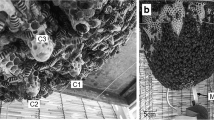Summary
Queens breathed continuously while they were piping, and were able to pipe with all spiracles except one blocked, so the sound could not have been produced by air entering or leaving the spiracles. It is produced by operating the flight motor without spreading the wings, and is radiated partly by the substratum, to which the vibrations are communicated by pressing the thorax against it.
Zusammenfassung
Königinnen atmeten während des Tütens ununterbrochen, und waren zum Tüten fähig, wenn alle Atemlöcher bis auf eines blockiert waren, so daß der Laut nicht durch Ein oder Austreten der Luft durch die Atemlöcher hervorgerufen sein konnte. Er wird erzeugt, indem der „flight motor” ohne das Ausbreiten der Flügel funktioniert, und teilweise durch das Substrat verbreitet, auf das die Schwingungen durch Anpressen des Thorax übertragen werden.
Similar content being viewed by others
References
Armbruster, L.: Über Bienentöne, Bienensprache und Bienengehör. Arch. Bienenk. 4, 221–259 (1922).
Bailey, L.: The respiratory currents in the tracheal system of the adult honey-bee. J. exp. Biol. 31, 589–593 (1954).
Bellesme, J. De: Note au sujet d'un travail adressé a l'Academie par M. J. Perez sur le bourdonnement des insectes. C. R. Acad. Sci. (Paris) 87, 535–536 (1878).
Hansson, Å.: Lauterzeugung und Lautauffassungsvermögen der Bienen. Opusc. entomol. (Lund), Suppl. 6 (1945).
Harris, W. H.: Remarks on the emission of musical notes and on the hovering habit of Eristalig tenax. J. Quekett micr. Club 8, 513–520 (1903).
Haskell, P. T.: Insect sounds. London: Witherby 1961.
Huber, F.: Nouvelles observations sur les abeilles. I. Geneva: Paschoud 1792.
Landois, H.: Die Ton- und Stimmapparate der Insekten in anatomisch-physiologischer und akustischer Beziehung. Z. wiss. Zool. 17, 107–186 (1867).
Örösi-Pàl, Z.: Wie tütet die Arbeitsbiene ? Zool. Anz. 98, 147–148 (1932).
Snodgrass, R. E.: Anatomy and physiology of the honeybee. New York: McGraw-Hill 1925.
—: Anatomy of the honeybee. New York: Cornell U. P. 1956.
Wenner, A. M.: Communication with honey bee queens by substrate sound. Science 138, 446–447 (1962).
Woods, E. F.: Queen piping. Bee World 37, 185–195, 216–219 (1956).
Author information
Authors and Affiliations
Additional information
Piping in English includes both “tüten” and “quaken” in German. Both sounds are produced in the same way but “quaken” is heard when the queen is in her cell (Armbruster, 1922).
Rights and permissions
About this article
Cite this article
Simpson, J. The mechanism of honey-bee queen piping. Zeitschrift für vergleichende physiologie 48, 277–282 (1964). https://doi.org/10.1007/BF00339456
Received:
Issue Date:
DOI: https://doi.org/10.1007/BF00339456




